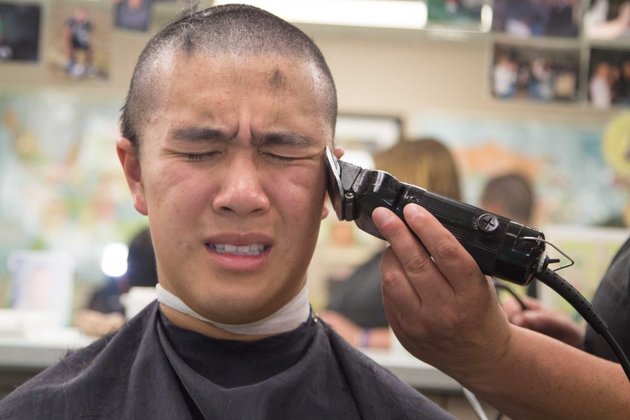2LT National News
Admissions Competition Is Fierce at US Military Academies
Jul 20, 2018
You may think you have what it takes to get into some of the U.S.’s most prestigious universities.
But we’re not talking about Ivy League schools. It might be easier to get into Cornell University, Brown University or Dartmouth College than some of the U.S. military academies – a handful of schools that are steeply competitive.
And these schools are not only tuition-free – the cost of educating a student at the U.S. Military Academy at West Point, New York, is estimated at $56,000 – students are paid to go there.
Service academies are federally funded universities that train students to become officers in the U.S. armed forces. After graduating, domestic students must serve for five years in their respective force, while international students return home to serve.
“We’re training them for military life and educating them, but then they’ll go home and serve for a certain amount of time,” said Brent Matthews, associate dean of international academic affairs at West Point.
The U.S. Military Academy and the four other service academies – the U.S. Naval Academy (USNA) in Annapolis, Maryland; the U.S. Air Force Academy (USAFA) in Colorado Springs, Colorado; the U.S. Coast Guard Academy (USCGA) in New London, Connecticut; and the U.S. Merchant Marine Academy (USMMA) in Kings Point, New York – welcome international students annually.
A new cadet reports to the cadet in the red sash during the U.S. Military Academy at West Point’s Reception Day, June 27, 2016. (Staff Sgt. Vito T. Bryant/U.S. Army)
U.S. federal policy allows the service academies combined to have 60 international students at a time, up from 45 in 2004. Students are called cadets at West Point, the Air Force Academy and the Coast Guard Academy. They are called midshipmen (nicknamed “middies”) at the Naval Academy and USMMA. Each year, eligible countries – this year about 100 – are selected by the U.S. State and Defense departments.
“They increased it [enrollment] to 60 to allow us to increase international relations with other countries,” said Deborah McDonald, director of admissions at West Point.
West Point admitted 16 international students to the Class of 2022 from countries in Asia, Europe and Africa, joining a class of more than 1,200.
McDonald said the admissions process for international students is similar to that for domestic students. “The big difference is that they need to receive a nomination through their state department,” she said. “They’re nominated by their home country, which is different than our process for U.S. citizens.”
Cadet 4th Class Chelsea Renfro stands at attention during the Class of 2014 Acceptance Day ceremony at the Air Force Academy, Aug. 4, 2010. (Mike Kaplan/U.S. Air Force)
U.S. applicants must secure a nomination from their local representative in Congress or Senate, or from the U.S. vice president.
Applicants to any of the five academies should be at least 17 years old, but no older than 22 prior to entry. They can’t be pregnant, married or responsible for the support of children.
International applicants of service academies must also take the Test of English as a Foreign Language (TOEFL) before being admitted. In 2016, the mean TOEFL score for West Point was 94 out of 120.
Potential international cadets must take the SAT standardized college admissions test and aim for above-average scores – around 1340 for West Point, 1400 for USNA, 1320 for USCGA, 1370 for USAFA and 1310 for USMMA, out of the highest score of 1600.
The Naval Academy admitted 14 international students to its Class of 2022 from countries in Europe, Africa and Asia.
“We average 60 to 80 nominations [a year],” Tim Disher, director of international programs at USNA, said. “We try to bring in 15 a year.”
The Air Force Academy admits about 15 international students annually and USMMA has slots for three full-time international students.
“Roughly about 10 apply each year,” Keith Watson, international admissions officer of USMMA, said. “Out of the 10 that apply, about half get in.”
The U.S. Coast Guard Academy Class of 2016 graduates and receives their commissions as officers during their commencement ceremony May 18, 2016. (Petty Officer 2nd Class Cory J. Mendenhall/U.S. Coast Guard)
When Saranjoe Sukcha began his academic career in 2015 at USCGA, there were only three other international students in his class. He was also the fifth Malaysian to attend USCGA – the fourth graduated in 1996.
“I feel blessed and extremely lucky to be selected after almost 20 years,” Sukcha said.
He was given the option of attending there, the Naval Academy at Annapolis, or the Australian Defense Force Academy.
“As an officer cadet in the Royal Malaysian Navy, I was selected with about 19 other candidates to undergo a selection process in order to get a spot in” the Naval Academy at Annapolis, the Coast Guard Academy in Connecticut or the Australian Defense Force Academy, Sukcha said.
International students are brought in before the domestic class for orientation and to help them get over jet lag, USNA’s Disher said. They attend a political science course to become more familiar with the U.S. Constitution. And they get a local “host” family.
For their service, first-year cadets are paid more than $900 a month. Part of that money goes into a personal checking account, and the other part goes into a separate account that helps cadets pay for uniforms, books, a computer, activity fees and other expenses.
When Sukcha told his family about the news, they had mixed reactions.
“My mother is very emotional,” Sukcha said. “She was crying, she was so happy.”
Others, however, were worried about how he would compare to the big, buff Americans they watch in movies.
“We’ve never had anyone in our family who was sent to other countries,” Sukcha said.



